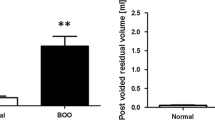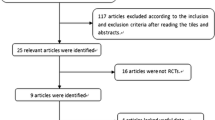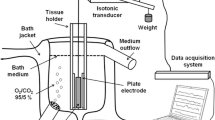Abstract
Antimuscarinics are the first-line choice of treatment for overactive bladder (OAB). Imidafenacin distributes in the bladder more selectively than in the submaxillary gland and colon, and hence, this drug is considered more useful for OAB than other antimuscarinics. However, the examination of imidafenacin selectivity to bladder over colon using in vivo models is limited. Thus, the author examined whether imidafenacin could induce more selective blockade of the bladder over colon in conscious rats using two pharmacological indices (colonic transit and neostigmine-induced fecal pellet output) and compared its bladder selectivity with propiverine. In the bladder study, the inhibitory doses of antimuscarinics were calculated using the area under the curve of the distension-induced rhythmic contraction in conscious rats. The relative bladder selectivity of imidafenacin to propiverine was 50-fold and 61-fold, respectively, in a dye marker colonic transit model and in a neostigmine-induced fecal pellet output model. This comparative study shows that the functional bladder selectivity of imidafenacin is higher than that of propiverine tested under the present conditions in conscious rats.




Similar content being viewed by others
References
Abrams P, Andersson KE (2007) Muscarinic receptor antagonists for overactive bladder. BJU Int 100:987–1006
Abrams P, Cardozo L, Fall M, Griffiths D, Rosier P, Ulmsten U, Van Kerrebroeck P, Victor A, Wein A (2003) The standardisation of terminology in lower urinary tract function: report from the Standardisation Sub-committee of the International Continence Society. Urology 61:37–49
Abrams P, Andersson KE, Buccafusco JJ, Chapple C, de Groat WC, Fryer AD, Kay G, Laties A, Nathanson NM, Pasricha PJ, Wein AJ (2006) Muscarinic receptors: their distribution and function in body systems, and the implications for treating overactive bladder. Br J Pharmacol 148:565–578
Andersson KE, Martin N, Nitti V (2013) Selective β3-adrenoceptor agonists in the treatment of the overactive bladder. J Urol 190:1173–1180
Bschleipfer T, Schukowski K, Weidner W, Grando SA, Schwantes U, Kummer W, Lips KS (2007) Expression and distribution of cholinergic receptors in the human urothelium. Life Sci 80:2303–2307
Campbell-Dittmeyer K, Hicks GA, Earnest DL, Greenwood-Van Meerveld B (2009) Increased colonic transit in rats produced by a combination of a cholinesterase inhibitor with a 5-HT4 receptor agonist. Neurogastroenterol Motil 21:1197-e108
Chapple CR (2000) Muscarinic receptor antagonists in the treatment of overactive bladder. Urology 55(suppl):33–46
Chen HI (1990) Evidence for the presynaptic action of 5-hydroxytryptamine and the involvement of purinergic innervation in the rabbit lower urinary tract. Br J Pharmacol 101:212–216
Chess-Williams Z (2002) Muscarinic receptors of the urinary bladder: detrusor, urothelial and prejunctional. Auton Autacoid Pharmacol 22:133–145
Eglen RM, Choppin A, Watson N (2001) Therapeutic opportunities from muscarinic receptor research. Trends Pharmacol Sci 22:409–414
Ehlert FJ, Griffin MT, Abe DM, Vo TH, Taketo MM, Manabe T, Matsui M (2005) The M2 muscarinic receptor mediates contraction through indirect mechanisms in mouse urinary bladder. J Pharmacol Exp Ther 313:368–378
Gonzalez A, Sarna SK (2001) Neural regulation of in vitro giant contractions in the rat colon. Am J Physiol Gastrointest Liver Physiol 281:G275–G282
Grider JR (2003) Reciprocal activity of longitudinal and circular muscle during intestinal peristaltic reflex. Am J Physiol Gastrointest Liver Physiol 284:G768–G775
Hanna-Mitchell AT, Beckel JM, Barbadora S, Kanai AJ, de Groat WC, Birder LA (2007) Non-neuronal acetylcholine and urinary bladder urothelium. Life Sci 80:2298–2302
Hata F, Kataoka T, Takeuchi T, Yagasaki O, Yamano N (1990) Differences in control of descending inhibition in the proximal and distal regions of rat colon. Br J Pharmacol 101:1011–1015
Hegde SS (2006) Muscarinic receptors in the bladder: from basic research to therapeutics. Br J Pharmacol 147:S80–S87
Kennedy C, Tasker PN, Gallacher G, Westfall TD (2007) Identification of atropine- and P2X1 receptor antagonist-resistant, neurogenic contractions of the urinary bladder. J Neurosci 27:845–851
Kim Y, Yoshimura N, Masuda H, de Miguel F, Chancellor MB (2005) Antimuscarinic agents exhibit local inhibitory effects on muscarinic receptors in bladder-afferent pathways. Urology 65:238–242
Kim Y, Yoshimura N, Masuda H, De Miguel F, Chancellor MB (2006) Intravesical instillation of human urine after oral administration of trospium, tolterodine and oxybutynin in a rat model of detrusor overactivity. BJU Int 97:400–403
Kirkpatrick CT, Rooney PJ (1982) Contractures produced by carbamate anticholinesterases in bovine tracheal smooth muscle. Clin Exp Pharmacol Physiol 9:603–611
Kishibayashi N, Karasawa A (1995) Stimulating effects of KW-5092, a novel gastroprokinetic agent, on the gastric emptying, small intestinal propulsion and colonic propulsion in rats. Jpn J Pharmacol 67:45–50
Kobayashi F, Yageta Y, Yamazaki T, Wakabayashi E, Inoue M, Segawa M, Matsuzawa S (2007) Pharmacological effects of imidafenacin (KRP-197/ONO-8025), a new bladder selective anti-cholinergic agent, in rats. Comparison of effects on urinary bladder capacity and contraction, salivary secretion and performance in the Morris water maze task. Arzneim Forsch 57:147–154
Kondo T, Nakajima M, Teraoka H, Unno T, Komori S, Yamada M, Kitazawa T (2011) Muscarinic receptor subtypes involved in regulation of colonic motility in mice: functional studies using muscarinic receptor-deficient mice. Eur J Pharmacol 670:236–243
Kugimiya T, Hanaoka K, Inada Y, Yamamoto Y, Marunaka T, Kawaguchi Y (1990) Phase I study of propiverine hydrochloride—the 1st report: single oral dosing study. Jpn J Clin Pharmacol Ther 21:555–565
Kullmann FA, Artim D, Beckel J, Barrick S, de Groat WC, Birder LA (2008) Heterogeneity of muscarinic receptor-mediated Ca2+ responses in cultured urothelial cells from rat. Am J Physiol Renal Physiol 294:F971–F981
Mansfield KJ (2010) Muscarinic receptor antagonists, the overactive bladder and efficacy against urinary urgency. Clin Med Insights Ther 2:471–480
Meek PD, Evang SD, Tadrous M, Roux-Lirange D, Triller DM, Gumustop B (2011) Overactive bladder drugs and constipation: a meta-analysis of randomized, placebo-controlled trials. Dig Dis Sci 56:7–18
Meini S, Maggi CA (1994) Evidence for a capsaicin-sensitive, tachykinin-mediated, component in the NANC contraction of the rat urinary bladder to nerve stimulation. Br J Pharmacol 112:1123–1131
Moro C, Chess-Williams R (2012) Non-adrenergic, non-cholinergic, non-purinergic contractions of the urothelium/lamina propria of the pig bladder. Auton Autacoid Pharmacol 32:53–59
Moro C, Uchiyama J, Chess-Williams R (2011) Urothelial/lamina propria spontaneous activity and the role of M3 muscarinic receptors in mediating rate responses to stretch and carbachol. Urology 78:1442.e9-e15
Nakamura T, Kimura J, Yamaguchi O (2002) Muscarinic M2 receptors inhibit Ca2+-activated K+ channels in rat bladder smooth muscle. Int J Urol 9:689–696
Nile CJ, Gillespie JI (2012) Interactions between cholinergic and prostaglandin signaling elements in the urothelium: role for muscarinic type 2 receptors. Urology 79:240.e17-e23
Ohno T, Nakade S, Nakayama K, Kitagawa J, Ueda S, Miyabe H, Masuda Y, Miyata Y (2007) Absolute bioavailability of imidafenacin after oral administration to healthy subjects. Br J Clin Pharmacol 65:197–202
Ono S, Mitsui R, Karaki S, Kuwahara A (2005) Muscarinic and 5-HT4 receptors participate in the regulation of the frequency of spontaneous contractions of the longitudinal muscle in rat distal colon. Biomed Res 26:173–177
Sawyer GW, Ehlert FJ (1998) Contractile roles of the M2 and M3 muscarinic receptors in the guinea pig colon. J Pharmacol Exp Ther 284:269–277
Sui G, Fry CH, Montgomery B, Roberts M, Wu R, Wu C (2014) Purinergic and muscarinic modulation of ATP release from the urothelium and its paracrine actions. Am J Physiol Renal Physiol 306:F286–F298
Tyagi S, Tyagi P, Van-le S, Yoshimura N, Chancellor MB, de Miguel F (2006) Qualitative and quantitative expression profile of muscarinic receptors in human urothelium and detrusor. J Urol 176:1673–1678
Yamada S, Ito Y, Taki Y, Seki M, Nanri M, Yamashita F, Morishita K, Komoto I, Yoshida K (2010) The N-oxide metabolite contributes to bladder selectivity resulting from oral propiverine: muscarinic receptor binding and pharmacokinetics. Drug Metab Dispos 38:1314–1321
Yamada S, Seki M, Ogoda M, Fukata A, Nakamura M, Ito Y (2011) Selective binding of bladder muscarinic receptors in relation to the pharmacokinetics of a novel antimuscarinic agent, imidafenacin, to treat overactive bladder. J Pharmacol Exp Ther 336:365–371
Yamazaki T, Muraki Y, Anraku T (2011) In vivo bladder selectivity of imidafenacin, a novel antimuscarinic agent, assessed by using an effectiveness index for bladder capacity in rats. Naunyn-Schmiedeberg’s Arch Pharmacol 384:319–329
Yoshida M, Inadome A, Maeda Y, Satoji Y, Masunaga K, Sugiyama Y, Murakami S (2006) Non-neuronal cholinergic system in human bladder urothelium. Urology 67:425–430
Acknowledgments
The author thanks Mr. Fumiyoshi Kobayashi, Mr. Kunio Someya, Mr. Takanobu Yamazaki, Mr. Tsuyoshi Anraku, and Mr. Tokutarou Yasue (Kyorin Pharmaceutical Co., Ltd.) for their helpful comments and advice.
Conflict of interest
The author declares that he has no competing interests.
Author information
Authors and Affiliations
Corresponding author
Rights and permissions
About this article
Cite this article
Muraki, Y. Comparative functional selectivity of imidafenacin and propiverine, antimuscarinic agents, for the urinary bladder over colon in conscious rats. Naunyn-Schmiedeberg's Arch Pharmacol 388, 1171–1178 (2015). https://doi.org/10.1007/s00210-015-1155-9
Received:
Accepted:
Published:
Issue Date:
DOI: https://doi.org/10.1007/s00210-015-1155-9




